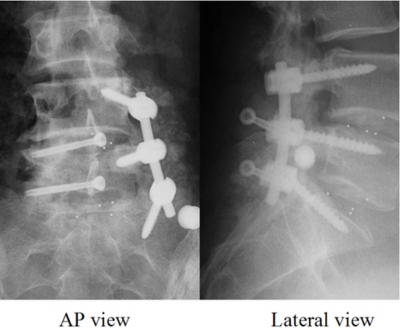Contralateral translaminar facet screw
Transforaminal lumbar interbody fusion (TLIF) has been used in lumbar degenerative diseases. Some researchers have applied unilateral fixation in TLIF to reduce operational trauma without compromising the clinical outcome, but it is always suspected biomechanically unstable. The supplementary contralateral translaminar facet screw (cTLFS) seemed to be able to overcome the inherent drawbacks of unilateral pedicle screw fixation theoretically.
Both unilateral pedicle screw fixation plus lumbar interbody fusion and unilateral pedicle screw fixation combined with contralateral translaminar facet screw fixation plus lumbar interbody fusion have advantages of small incision, minimal invasion, simple operation, reliable stability, high interbody fusion rate,rapid recovery, encouraging clinical effects and less complications. Compared with unilateral pedicle screw fixation combined with contralateral translaminar facet screw fixation, the operation of unilateral pedicle screw fixation is simpler and can avoid using special equipments. Therefore, unilateral pedicle screw fixation plus lumbar interbody fusion can be used in treating single-segmental lower lumbar vertebra diseases under the precondition of strictly grasping indications for surgery and improving surgical skills 1).
The hybrid construct of unilateral pedicle screw (UPS) + translaminar facet screw (TLFS) showed instant and long-term equivalent biomechanical ability to that of traditional BPS, making it an alternative option to BPS that could be less invasive while maintains a stable and effective instrumentation 2).
Three instrumentation systems were tested randomly: unilateral pedicle screw (UPS), UPS with contralateral translaminar facet screw (UPSFS), and bilateral pedicle screw (BPS).
The range of motion (ROM) and the neutral zone (NZ) of L3-5 were measured.
All fixation types could reduce the ROM of L3-5 significantly in flexion, extension, and lateral bending, compared with the intact state. In axial torsion, only BPS reduced the ROM significantly, compared with the intact state. The UPSFS technique provided intermediate stability, which was superior to the UPS in flexion-extension and lateral bending, and inferior to the BPS in lateral bending. Compared with the intact state, the NZs decreased significantly for UPS, UPSFS, and BPS in flexion-extension, while not significantly in lateral bending and axial torsion.
In this study, among the 3 fixation techniques, BPS offered the highest stability, UPSFS provided intermediate stability, and UPS was the least stable for 2-level lumbar spinal disorders. UPSFS appeared to be able to offer a less invasive choice than BPS in well-selected patients with 2-level lumbar spinal disorders 3).
